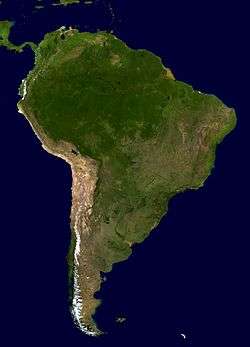Orocline
An orocline — from the Greek words for "mountain" and "to bend" — is a bend or curvature of an orogeneic (mountain building) belt imposed after it was formed.[1] The term was introduced by S. Warren Carey in 1955 in a paper setting forth how complex shapes of various orogenic belts could be explained by actual bending, and that understanding this provided "the key to understanding the evolution of the continents".[2] Carey showed that in a dozen cases where such bends were undone the results were substantially identical with continental reconstructions deduced by other means.[3] Recognition of oroclinal bending provided strong support to the subsequent theory of plate tectonics.
List of oroclines

A composite relief image of South America. The Bolivian Orocline can be seen in the middle of the picture next to the Pacific Ocean. Further south it also possible to hint the less pronounced Maipo Orocline.
- The Bolivian Orocline is a seaward concave bending in the coast of South America and the Andes mountains at about 18° S.[4][5] At this point the orientation of the Andes turns from Northwest in Peru to South in Chile and Argentina.[5] The Andean segment north and south of the orocline have been rotated 15° to 20° counter clockwise and clockwise respectively.[5][6] The orocline area overlaps with the area of maximum width of the Altiplano Plateau according to Isacks (1988) the orocline is related to crustal shortening.[4] The specific point at 18° S where the coastline bends is known as the Arica Elbow.[7]
- The Maipo Orocline or Maipo Transition Zone is an orocline located between 30° S and 38°S in the Andes with a break in trend at 33° S.[8]
Notes
- ↑ Carey 1955, p. 257. Note that the initial formation does not have to be straight.
- ↑ Carey 1955, p. 257.
- ↑ Carey 1955, p. 255.
- 1 2 Isacks, Bryan L. (1988), "Uplift of the Central Andean Plateau and Bending of the Bolivian Orocline" (PDF), Journal of Geophysical Research, 93 (B4): 3211–3231, doi:10.1029/jb093ib04p03211
- 1 2 3 Kley, J. (1999), "Geologic and geometric constraints on a kinematic model of the Bolivian orocline", Journal of South American Earth Sciences, 12 (2): 221–235, doi:10.1016/s0895-9811(99)00015-2
- ↑ Beck, Myrl E. (1987), "Tectonic rotations on the leading edge of South America: The Bolivian orocline revisited", Geology, 15 (9): 806–808, doi:10.1130/0091-7613(1987)15<806:trotle>2.0.co;2
- ↑ Prezzi, Claudia B.; Vilas, Juan F. (1998). "New evidence of clockwise vertical axis rotations south of the Arica elbow (Argentine Puna)". Tectonophysics. 292: 85–100. doi:10.1016/s0040-1951(98)00058-4.
- ↑ Arriagada, César; Ferrando, Rodolfo; Córdova, Loreto; Morata, Diego; Roperch, Pierrick (2013), "The Maipo Orocline: A first scale structural feature in the Miocene to Recent geodynamic evolution in the central Chilean Andes" (PDF), Andean Geology, 40 (3): 419–437
References
- Carey, S. Warren (1955), "The Orocline Concept in Geotectonics, Part I" (PDF), Papers and Proceedings of the Royal Society of Tasmania, 89: 255–288.
External links
- Van der Voo, Rob (December 2004), "Paleomagnetism, Oroclines, and Growth of the Continental Crust" (PDF), GSA Today, 14 (12): 4–9, doi:10.1130/1052-5173(2004)014<4:POAGOT>2.0.CO;2.
This article is issued from Wikipedia - version of the 6/13/2016. The text is available under the Creative Commons Attribution/Share Alike but additional terms may apply for the media files.